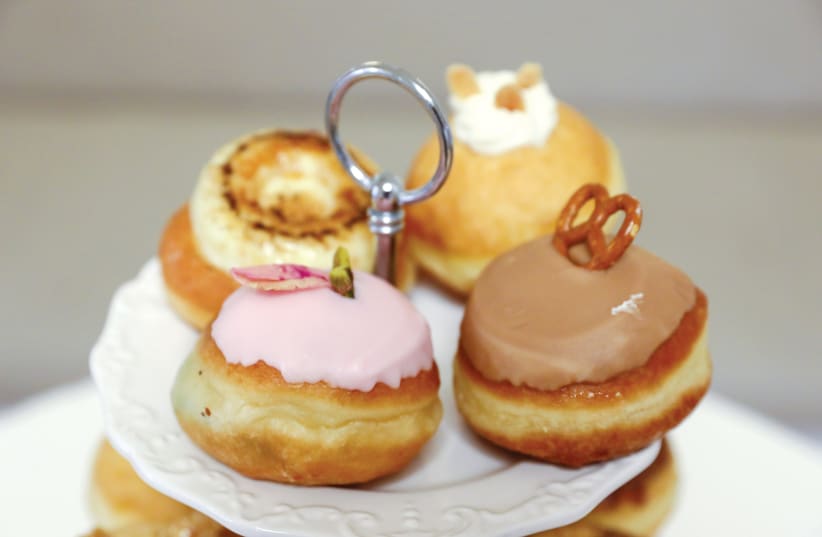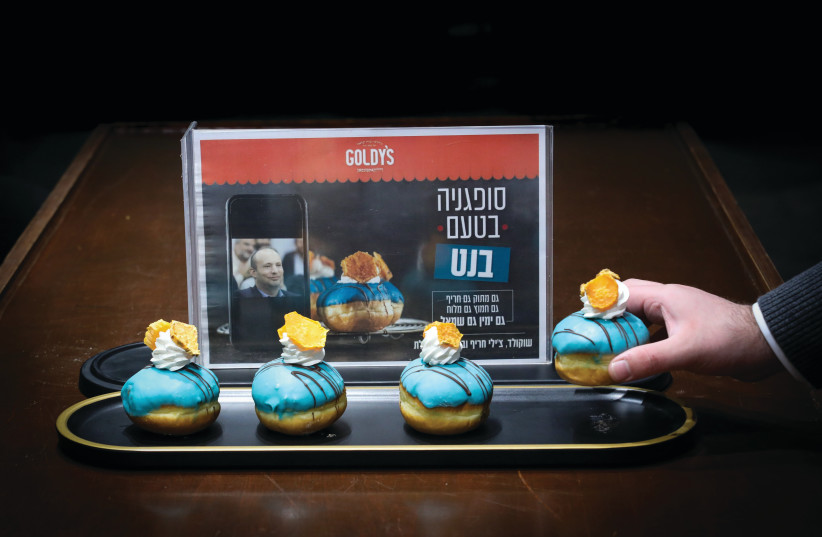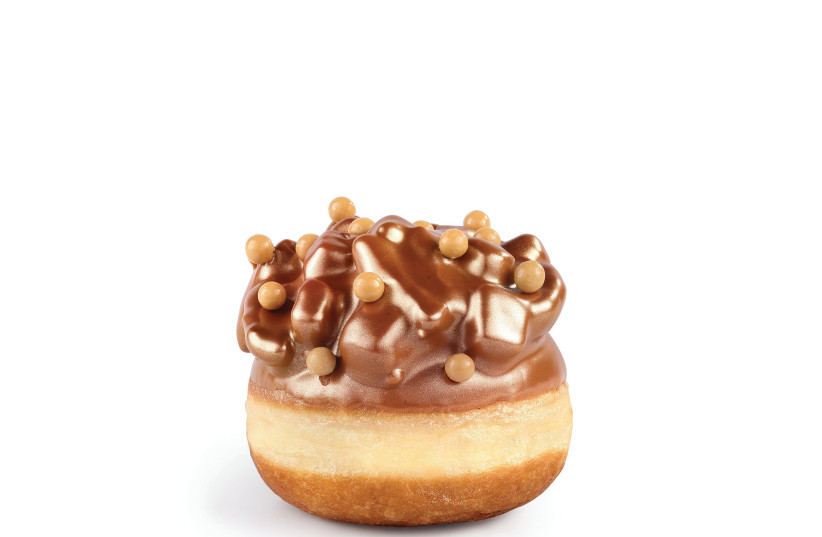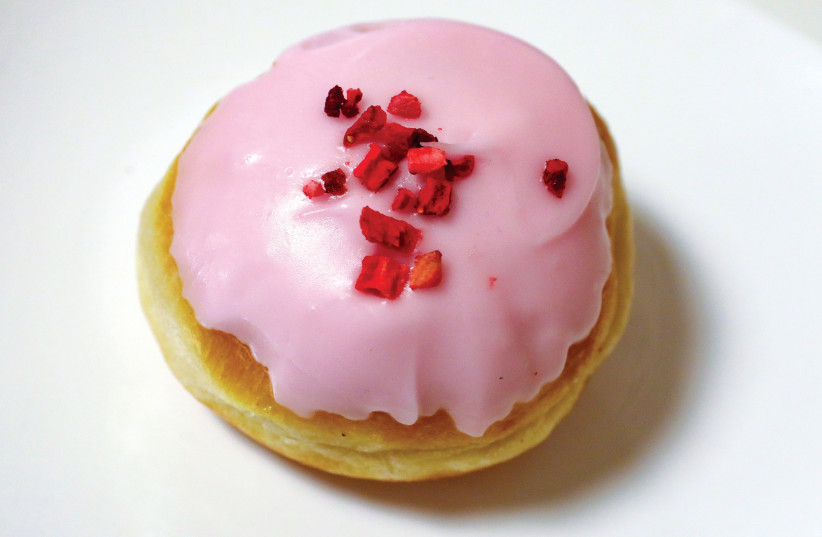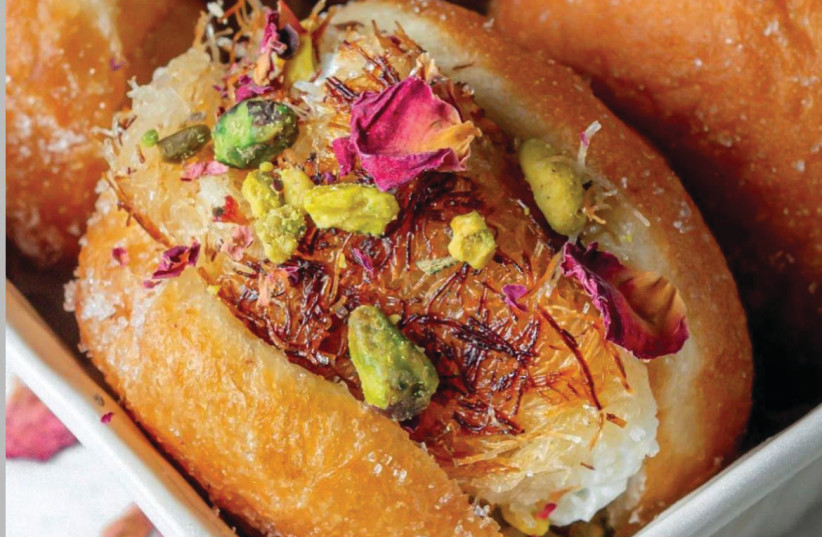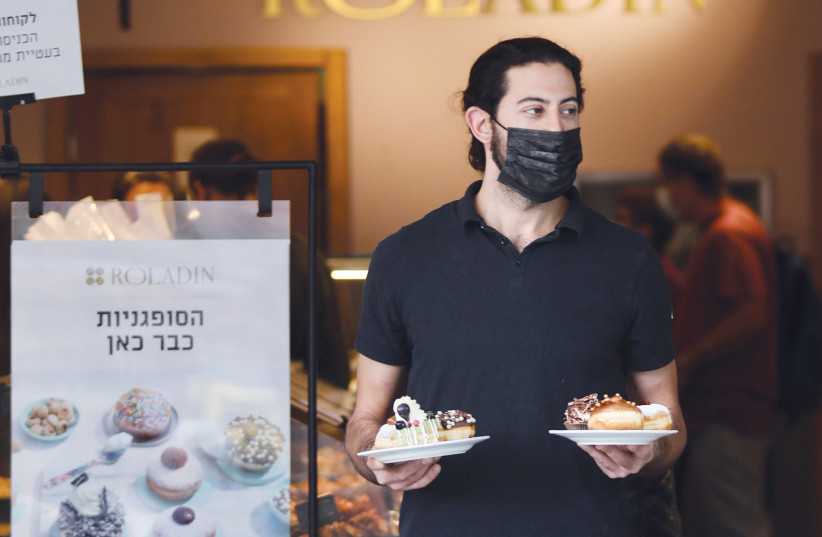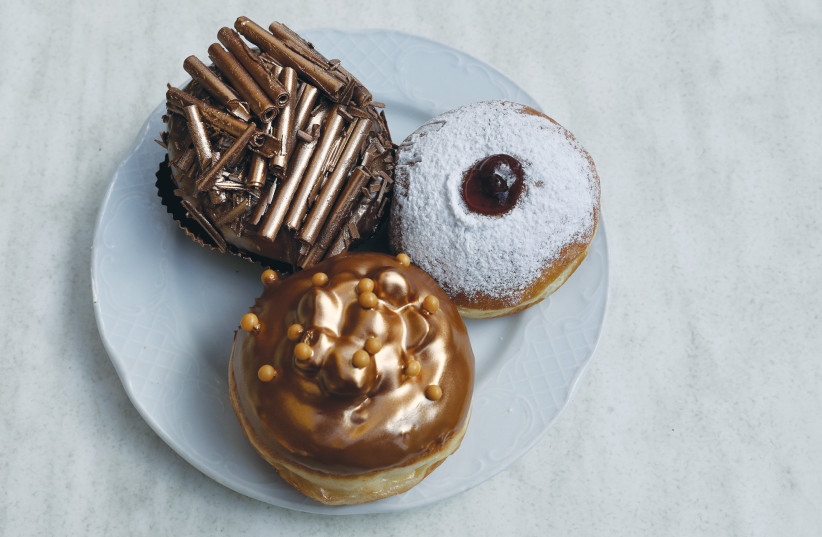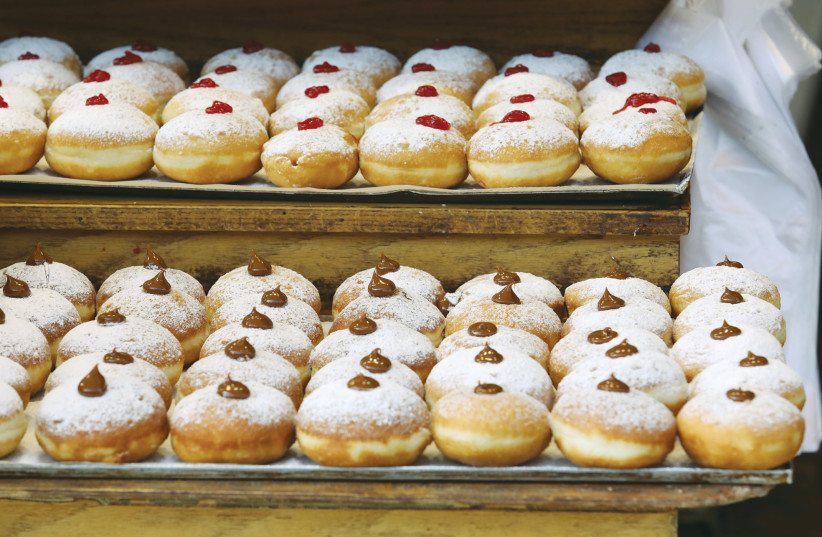Every year, people who watch their weight ask: If I allow myself only one sufganiya this year, what should it be?
This year, the answer requires a proper study of Jewish history, as well as recent global trends that have spread to Israel.
There are two traditions of foods to eat on Hanukkah: oily and dairy foods.
The oily foods are obviously intended to recall the Hanukkah miracle of the small flask of one day’s worth of pure oil that lasted for eight, when the Holy Temple was rededicated after being defiled by the Greeks. Jews express appreciation to God for the oil miracle by lighting candles, as well as eating both potato latkes and sufganiyot.
According to hassidic teachings, oil symbolizes the deepest part of the human soul that connects to God. It is also symbolic that oil rises above other liquids rather than mixing with them, in a message against assimilation, which was the true villain of the Hanukkah story.
But there is also a lesser-known tradition of eating dairy foods, which recalls the story of Judith, the courageous daughter of Yohanan the high priest during the Maccabean Revolt, who killed the Greek general Holofernes after feeding him cheese when he wanted to seduce her.
Besides the #MeToo connection, Judith’s brave act was the key to the military victory which is the other miracle celebrated on Hanukkah.
Rabbi Moshe Isserles, the top codifier of Ashkenazi traditions, holds that eating dairy foods is the correct custom of Hanukkah, and does not even mention oily foods.
Keeping that in mind, eating cheap, parve, jelly-filled doughnuts satisfies only the oily foods tradition, while eating fancier, more expensive dairy sufganiyot properly fulfills both, thereby celebrating both miracles.
But not every dairy sufganiya is ideal by Jewish tradition, because until very recently, there surprisingly has been no custom of eating sweet food on Hanukkah, like there is on Rosh Hashanah. Eating a salty sufganiya on Hanukkah, however, has a basis, because Hanukkah marks the rededication of the Temple, where salt played a major role.
The ideal sufganiya would therefore combine the current custom of eating sweet sufganiyot with the traditions of the oily and the dairy and be salty as well.
Enter the salted caramel sufganiya, which meets all the criteria and blends two flavors to double the taste sensation.
Salted caramel is a trend in France, the United States and United Kingdom that has recently spread to Israel. It started with a French pastry chef and was eventually spread in the US by Starbucks, Häagen-Dazs and – more recently – M&Ms. Salted caramel Twix first came out two months ago.
In Israel, salted caramel ice cream has been popularized by the Golda chain. But the salted caramel sufganiya is taking the trend here to the next level. It is a perfect fit, both in taste and in properly marking the holiday and expressing gratitude for its miracles.
It is much better than your standard dulce de leche (ribat halav) sufganiyot which merely combine sweet with more sweet and are sometimes frighteningly parve.
THE ROLADIN chain of bakeries has presented the salted caramel sufganiya in different forms in recent years. This year, salted caramel is featured in a work of art of a pastry called Bisuitella Caramel, which includes vanilla ganache, toffee crumble caramelized pecans, butter cookie crumbs, caramel icing and a salted caramel chaser.
“Every year, Roladin is inspired by global trends, and one of the boldest is the combination of sweet and salty,” Roladin director-general Noa Bachar Aharoni said. “The Bisuitella Caramel sufganiya succeeds with its taste in awakening all of the senses and challenging the Israeli palate to experience a full gamut of flavors that leave you wanting more. There is no doubt that it is one of the most successful, most sold sufganiyot in our current collection.”
There are 94 branches of Roladin nationwide, including six in Jerusalem, two in Modi’in and one in Mevaseret Zion. Roladin workers are trained every year in the company’s “Sufganiyot Academy” to understand the secrets of how to create each year’s collection and keep them fresh.
The French bakery Gourmandises, which took over the Friends of Zion Museum cafeteria downtown on Yosef Rivlin Street, also has salted caramel sufganiyot this year.
The owners of the bakery, Livnatt Affriat and her husband, chef Yoel Affriat, said salted caramel is being used more and more in their native France.
“I love the combination of the sweet and the salty but not too salty,” said Livnatt, whose bakery also features a salty pretzel sufganiya, with vanilla creme patissiere, pretzel crumbs inside the dough and an actual pretzel on top.
The pickiest of our tasters found the lychee sufganiyot at Gourmandises to be especially authentic, light and refreshing.
Livnatt said her new location in a museum aimed at Evangelical Christians allowed her to teach her new clientele about the importance of sufganiyot, while continuing outreach to current clients and whatever tourists come downtown this holiday.
“The tourism is starting to wake up again,” she said. “We are starting see the sweet light at the end of the tunnel.”
Jerusalem’s most popular bakery, Kadosh, not far away on Shlomzion Hamalka Street, is premiering this Hanukkah what it calls “the Old City Sufganiya,” which includes caramel, halva, pistachios and sesame seeds.
Kadosh, whose NIS 18 sufganiyot are Jerusalem’s most expensive, always has a line for buying takeout going down toward the Old City, especially as Hanukkah approaches.
The creative bakery is also selling croissant sufganiyot, knafeh sufganiyot, and continues selling the sufganiya called Abu Dhabi which premiered last year, celebrating the peace agreement with the United Arab Emirates using dates provided by Abu Dhabi’s Jewish community.
The pastry chefs, Itzik and Keren Kadosh, hand-make all the sufganiyot on site to ensure the ultimate quality and freshness. The result is well worth both the wait and the price.
When we came to sample the delicious pineapple and raspberry sufganiyot that were available at the time, the long line included people who came all the way from Rehovot, just to try them.
If you have time, it’s worth staying all day and trying various flavors as new fresh sufganiyot arrive as soon as they are ready.
Even smaller family bakeries are joining the salted caramel craze this year. Moti Binyamin, who owns Bourekas Ima in Baka, said he would have them for the first time, in addition to several other flavors he has sold in the past.
In an effort to compete with Roladin down the street, the sufganiyot at Bourekas Ima have become more attractive-looking on the outside, without losing their special taste on the inside that kids love year after year.
Next door on Rivka Street, a branch of the English Cake chain of bakeries defiantly decided to buck the salted caramel trend. A source at the bakery revealed that it started making them and then purposely gave up.
“Because salted caramel is a trend, I didn’t want to do it,” the source said, perhaps counterintuitively. “It is just too popular and too easy to find elsewhere.”
English Cake does feature a white chocolate cheesecake sufganiya that fits with the spirit of the holiday and could have been good enough for Judith to trick Holofernes. But none of the 14 flavors in this year’s collection is anything but sweet, and a concoction called a “red velvet sufganiya” looks lovely but had an unpleasant taste.
One sufganiya that was appreciated by our hardest-working taster was a coffee sufganiya from La Patissiere bakery on Keren Kayemet Street in Rehavia, which has not joined the salted caramel trend.
There are salted caramel sufganiyot at Goldy’s bakery on Ezrat Torah Street, which has perhaps the most unconventional sufganiya: The Naftali Bennett Sufganiya. It comes with a picture of the prime minister, and the bakery’s website describes the sufganiya as having an “unbalanced flavor of spicy, sour, sweet, Right and Left, with chocolate, spicy chili and caramelized sweet potato.”
THERE WERE no pictures of politicians, but the sufganiyot from Roladin came in a beautiful box. Aesthetics are very important to Roladin, from the box to the minutest detail of each sufganiya.
“The visual is what wins in our campaign,” Bachar Aharoni said. “It is very colorful and pretty to get our customers’ emotions to a new level.”
Bachar Aharoni said her customers come to Roladin in the weeks ahead of Hanukkah, buying one sufganiya at a time to sample them and decide which is best, in order to prepare themselves for Hanukkah, when they will know what to order in larger quantities for their families.
Roladin overcame the COVID crisis by building up its home delivery business. This year, that is less of a problem, because all branches are fully operational.
If anything, the coronavirus could boost business this year, because Hanukkah comes as parents are taking their children to get vaccinated, and there is no better reward for keeping calm while getting jabbed than a sufganiya with its own shot ready in its accompanying syringe. Bachar Aharoni revealed that the chasers have become more round in an effort to eliminate such comparisons, and the kids who sampled the sufganiyot said they did not evoke any fear.
The children, aged five to 44, who sampled the sufganiyot said they could taste the difference between a basic parve strawberry sufganiya available at any grocery store and a fancy dairy sufganiya from Roladin. One child spoke of “seeing a whole new world of a sufganiya” as she bit into it, while another said “when you take a bite, you get a handful of different flavors.”
Another commented that adding raspberry from the chaser allows us to do our part in making the sufganiya ready to be eaten on Hanukkah and take part in the miracle. Regarding the salted caramel Bisuitella Caramel sufganiya, a wise child said the sweet and salty combination is fitting for Hanukkah and asked if it means she doesn’t have to grate any potatoes for latkes this year (see sidebar).
The salted caramel sufganiya is indeed an ideal way of celebrating Hanukkah. Perhaps the true miracle will be if we limit ourselves to only one.
